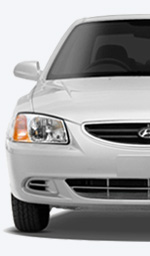 printable version printable version
Anti-lock brakes
METHODS correct braking
Before driving after parking, be sure the parking brake is off and that the brake system warning lamp is off.
After going through water or washing the car, the brakes may get wet. Wet brakes are very dangerous as the vehicle can not stop quickly. To dry the brakes, gently press on them while driving until normal braking will not, taking care not to lose control of the vehicle.
Do not roll downhill in neutral gear. Always keep the transmission enabled while driving, use the brakes to reduce the speed of the car, then downshift so that the engine braking helping to maintain a safe speed.
Avoid driving style with frequent heavy braking. Do not hold your left foot on the brake pedal continuously while driving, it can be dangerous, because it leads to overheating of the brakes and lost their effectiveness. It also leads to increased wear of brake parts. If during movement occurred puncture, slightly depress the brake pedal and try to keep the car straight during deceleration. When you have enough to reduce speed, leaving the road and completely stop the vehicle in a safe place. If your car is equipped with an automatic transmission, do not move the car slowly forward. For this purpose, when the car is stopped, keep your foot on the brake pedal.
Take precautions when parking on a slope. Apply the parking brake and move the selector lever to position "P" (automatic transmission) or the gear shift lever in neutral (manual gearbox). When parking on a slope, expand the front wheels in the direction of the border to prevent the car from rolling. When the parking lot is on the rise, expand the front wheels away from the curb to prevent the car from rolling. If there is no curb or necessary to prevent the car from rolling for other reasons, block the wheels.
Under some conditions your parking brake can freeze in the engaged position. This happens when there are rear brakes accumulated snow or ice, or, if the rear brakes are wet. If there is a risk that the parking brake may freeze, turn it on only for a while until you move the lever to position "P" (automatic transmission) or the gearshift lever in first gear or reverse gear, to thereby block the wheels vehicle. Then release the parking brake.
Do not hold the vehicle on a slope with the help of the accelerator pedal. This can lead to overheating of the gearbox. Always use the brake pedal or parking brake.
LOCK BRAKING SYSTEM
Anti-lock brake system (ABS) prevents the wheels from locking under heavy braking or when driving on the road with uneven surface. The electronic control unit Anti-lock brake system (ABS) monitors wheel speed of the car and adjusts the brake fluid pressure in each wheel cylinder. Thus, in an emergency or on a smooth road, this system improves the car's handling during braking.
A warning  During the anti-lock braking systems (ABS) for braking on the brake pedal can be felt faint ripple. Also, while driving, you can hear the noise in the engine compartment. These phenomena are normal and indicate that the anti-lock brake system (ABS) is working properly. During the anti-lock braking systems (ABS) for braking on the brake pedal can be felt faint ripple. Also, while driving, you can hear the noise in the engine compartment. These phenomena are normal and indicate that the anti-lock brake system (ABS) is working properly.
 Anti-lock brakes (ABS) can not prevent traffic accidents due to improper or dangerous maneuvers. While it improves the car's handling during emergency braking, always observe the safe distance from the vehicle in front. Vehicle speed must be reduced in adverse driving conditions. Anti-lock brakes (ABS) can not prevent traffic accidents due to improper or dangerous maneuvers. While it improves the car's handling during emergency braking, always observe the safe distance from the vehicle in front. Vehicle speed must be reduced in adverse driving conditions.
 In the following cases the braking distance vehicles with anti-lock braking system ABS may be longer than the car without her: In the following cases the braking distance vehicles with anti-lock braking system ABS may be longer than the car without her:
- When driving on gravel roads and roads covered with snow;
- When driving with snow chains installed;
- When driving on roads, the surface of which there are bumps, pits, etc., on bumpy roads or other roads with poor coverage.
 Speed of movement on such roads should be reduced. Do not check the security provided by cars equipped with anti-lock brake system (ABS) by cornering or driving at high speeds, because it can be dangerous to you and others. Speed of movement on such roads should be reduced. Do not check the security provided by cars equipped with anti-lock brake system (ABS) by cornering or driving at high speeds, because it can be dangerous to you and others.
|







